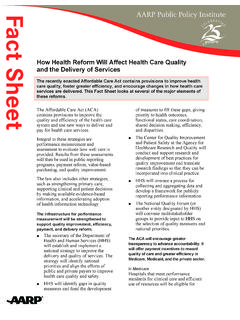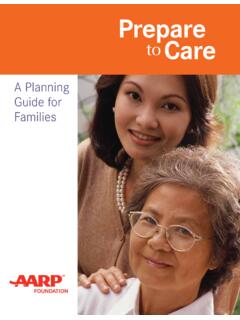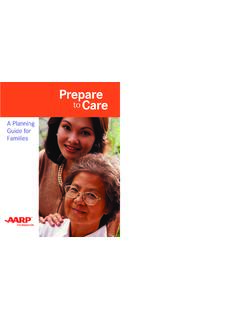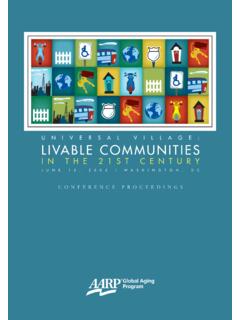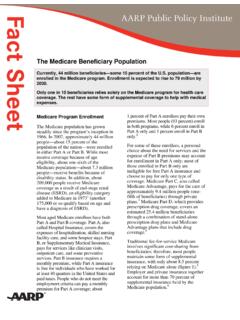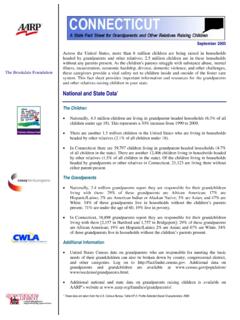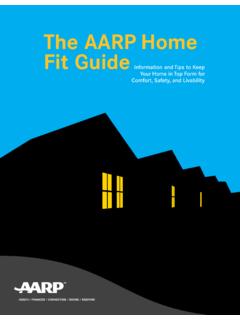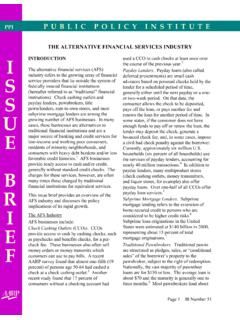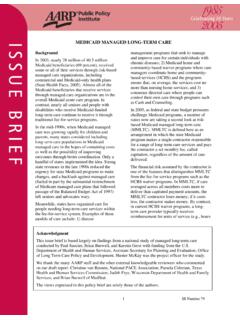Transcription of Chronic Conditions Among older Americans - AARP
1 1 Chronic Conditions Among older Americans Chronic Illness on the Rise How Much Do We Spend on Chronic Conditions ? A Closer Look at Selected Chronic Conditions 9. Chronic Conditions Among older Americans In this chapter, we describe the extent of Chronic illness in America and its implications for health care delivery and cost. Tremendous changes in medical science, combined with shifts in lifestyle and demographics, have resulted in a rapid rise in the number and proportion of individuals living with one or more Chronic illnesses. older Americans are especially vulnerable to Chronic disease. Today more than 70 million Americans ages 50 and older four out of five older adults suffer from at least one Chronic condition.
2 More than 70 million Americans ages 50 and older four out of five older adults . suffer from at least one Chronic condition.. The reasons for the rapid rise in Chronic illness are varied. They include the aging of the population, longer life expectancies due to improvements in medical care for infectious diseases, and advances in diagnostic technology and treatment options for many Chronic diseases. In addition, changes in lifestyle contribute to higher rates of Chronic illnesses such as diabetes, high blood pressure, and heart disease. The health consequences of Chronic illness are extensive.
3 People with Chronic diseases often have difficulty with basic tasks such as lifting objects or walking up steps, or daily life activities such as bathing, dressing, or eating. They have significantly higher rates of hospitalization and make more emergency room (ER) visits. Their health care spending (shared Among patients and payers) is higher than that for people without a Chronic disease. 10 Chronic Care: A Call to Action for Health Reform A closer look at particular Chronic Bloomberg School of Public Health. Conditions , often for many years. illnesses shows similar patterns All references to the 2005 MEPS Changes in the way Americans live, high spending, above-average or 2006 Medicare data indicate eat, work, and play contribute to use of hospital and ER visits, and findings derived from those increased prevalence of Chronic presence of multiple, often related analyses.
4 Other data sources are Conditions like diabetes, high Conditions . The particular strategies referenced as appropriate. blood pressure, and heart disease, for successful care management while improved treatments for of these Conditions will vary with What Is Chronic Illness? such Conditions as cancer and the Conditions , but we see several Chronic illnesses are ongoing congestive heart failure extend common themes from the patterns (usually lasting a year or more), life expectancy. A major challenge of care and the research literature generally incurable illnesses or for our health care system in the that point to the potential benefit Conditions that require ongoing 21st century is developing better from better coordination and medical attention and affect a ways of caring for people with support for people with Chronic person's daily life (Hwang, Weller, Chronic illness.)
5 Conditions and their caregivers. Ireys, & Anderson, 2001; Anderson Today, the statistics on Chronic & Horvath, 2004; National Center In this chapter, we characterize disease are staggering (AHRQ, 2005). for Health Statistics, 2008). Chronic the impact of various Chronic (Figures and ): diseases are often preventable. Conditions on individuals, their They are managed with good health families, and their caregivers. care from clinicians and care of More comprehensive studies of their own Conditions by people, all Chronic Conditions have been with help from family members and undertaken by other authors (see, other informal caregivers.
6 Some for example, Anderson, Horvath, of the most prevalent and costly Knickman, Colby, Schear, &. Chronic diseases include arthritis, Jung, 2002; Centers for Disease asthma, cancer, cardiovascular Control and Prevention [CDC], (heart) disease, depression, and 2004; Centers for the Evaluative diabetes, though these are only a Clinical Sciences and Dartmouth few of many illnesses that lower the Medical School, 2006; Alliance quality of life of Americans . for Aging Research, no date). Most of the data and statistics on Chronic Illness on the Rise Chronic illness presented in this The latter half of the 20th century chapter come from analyses using was a time of tremendous advances the 2005 Medicare Expenditure in treating infectious diseases and Panel Survey (MEPS)1 and 1997 extending life for all Americans .
7 Source: Johns Hopkins Bloomberg and 2006 Medicare claims One side effect of this success School of Public Health analysis These analyses were conducted by of Medical Expenditure Panel is that more Americans ages 50 Survey, 2005. researchers at the Johns Hopkins and older are living with Chronic Note: Data do not include people who live in institutions. PART 1: Chronic Conditions Among older Americans 11. More than 70 million Americans Chronic disease is an increasing Why Are Chronic Conditions ages 50 and older four out of burden for older Americans a Growing Problem? five older adults suffer from at (Figure ): What explains the growing least one Chronic condition.
8 Prevalence of many Chronic The prevalence of diabetes More than half of older adults Among adults ages 65 and older diseases? Several factors are at have more than one Chronic increased by more than 50 work. Longer life expectancy is condition, and 11 million percent between 1997 and 2006 one key factor. The aging of the live with five or more (CMS, 1997, 2006). population also contributes to Chronic Conditions . higher rates of Chronic disease. The prevalence of mental illness Advances in treatment for Chronic Over 40 percent of all older increased almost 70 illness lead to more people being Americans have high blood All told, the share of Medicare screened and diagnosed with pressure, and more than one in beneficiaries with five or more disease, while changes in clinical four has high cholesterol.
9 Conditions increased from about practice have broadened the Almost 20 percent of older 30 percent in 1987 to more than definitions for many Chronic Americans suffer from some sort 50 percent in 2002 (Thorpe & Conditions . Finally, lifestyle factors, of mental illness. Howard, 2006). including smoking, changes in Almost 15 percent have diabetes. exercise habits, and the growing Source: Johns Hopkins Source: Johns Hopkins Bloomberg School of Public Health analysis of Medicare claims data. Bloomberg School of Public Note: Prevalence figures shown here are based on Medicare claims data and vary significantly Health analysis of Medical from prevalence data drawn from MEPS data.
10 Medicare claims data are derived from 5 percent Expenditure Panel Survey, 2005. sample of beneficiaries over 65 enrolled in Parts A and B, excluding Part C and ESRD. Note: Data do not include people who live in institutions. 12 Chronic Care: A Call to Action for Health Reform prevalence of obesity contribute to account for more than 80 percent of service program, the prevalence higher rates of Chronic illness. deaths (Steinbrook, 2004). was over 22 percent in 2006, up from percent in 1997, Longer life expectancy is one As the population ages, we see an increase of over 50 percent. important reason why more higher rates of Chronic illnesses Similarly, the prevalence rate for Americans are developing Chronic that appear later in life.
